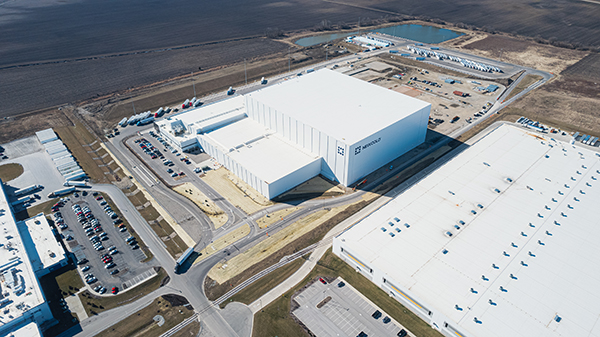Unveiling next-gen strategies for supply chain resilience, automation and eco-friendly practices in 2024.
By Jonas Swarttouw, Executive Vice President and Chairman of NewCold North America
The recent supply chain disruption caused by attacks on ships in the Red Sea underlines the lessons learned during Covid. Not long ago, long lines at ports and clogged canals dominated headlines. Supply chains and their pandemic-related delays were common topics of discussion, making a typically niche industry a staple of dinner-table conversations. The White House recently established a Council on Supply Chain Resilience to ensure we keep heading in the right direction and avoid reverting to those difficult days.
While the industry has recovered a little more with every year since, a multitude of challenges await supply chain professionals in the days ahead. Supply chains will continue to be impacted by geopolitics, trade wars, and real wars. The Red Sea disruption is a case in point.
The food supply chain has plenty to consider, from seasonal shifts in harvest cycles to safe and efficient warehousing to streamlined delivery. Add in the wild card of ever-changing consumer trends, and it’s clear how much volatility the industry must endure. When done right, supply chains can be vital to lowering inflation.
We know more than we did three years ago, and looking at where we came from can help us determine where we are headed. As ongoing global uncertainty drives home the lessons of Covid, we know that resilience and reshoring will be key to supply chain success in 2024. But what else can supply chain professionals expect? And how do we win progress and mitigate risks?
Let’s dig deeper with five predictions of what will come next year.
Supply chains have evolved over the years, and it was clear that resiliency will be critical to adapting in 2024 and beyond, even before the new council was established. Traditionally, logistics was about finding the lowest costs. Then, it was about cost control and service. Delivering in full, and on time, was a necessity. Now logistics requires all three if companies are to withstand forthcoming challenges — costs, service, and resilience.
This new revolution brings a greater focus on scalability and automation to adjust to needs at any moment. In a recent survey, 89% of respondents reported that the top concern driving their need for process automation was supply chain resiliency.

Today’s warehouses are larger than ever — CBRE data shows the majority in North America are between 200,000 and 499,999 square feet. Facilities so massive can’t be operated entirely by manual labor. And while rising costs of materials and inflation have caused the costs associated with automated warehouses to increase over the last three years, research shows that 26% of warehouses are expected to be automated by 2027— a dramatic rise from 18% in 2021. There is a first-mover advantage for investors to act now as inflation continues to drive up costs. The organizations that introduce automation now will likely save themselves from even higher costs in the future and will have the ability to make their warehouses more efficient and effective by the time their competitors enter the playing field.
Not only will automation continue to be a game changer in how we operate warehouses – it will play a role in who operates warehouses. A survey conducted by Vecna Robotics reported that 70% of supply chain professionals have seen improved retention as a result of implementation, and over half recognized it as a way to upskill employees and create new job opportunities. Companies that leverage robotics and automation can make their facilities more efficient despite their large footprint. The report shows 85% of warehouse operators plan to deploy automation within 12 months.
Consumer behavior has influenced a shift toward sustainability. In fact, according to one report, 78% of consumers want companies to do more to make sustainable food, yet 38% don’t trust companies to be honest about their environmental impact.
To bridge this gap, we’re seeing a growing emergence in Scope 3 reporting. Over one-third of supply chain CEOs report they are reducing total Scope 3 emissions, and we expect it to become a larger trend in the industry as organizations begin to reap the benefits it provides. Most often, organizations measure Scope 3 emissions primarily around transportation — but Scope 3 includes the warehouse as well. Focusing on Scope 3 emissions in the warehouse helps to increase transparency between consumers and producers, as well as discover untapped opportunities for impact across your entire supply chain. A few early adopters have already begun measuring for Scope 3 across their supply chain, and we expect it to become a larger industry standard as more organizations follow suit.
The rise in Artificial Intelligence (AI) tool releases dominated headlines in 2023. While the lines between AI and software will continue to blur as new products become available, we know the adage “garbage in, garbage out” will remain true. In other words: to get quality output from AI, you need to input quality data.
This is an area of opportunity for logistics providers in 2024. Automated warehouses generate vast amounts of data and use it to measure whether systems are working appropriately. Efforts to establish practices that enable good data collection, data cleaning, and standardized data exchange between departments should be prioritized with the goal of better developing algorithms and processes. Companies that take these steps now will be well-positioned as AI tools continue to come on the market and become part of everyday operations over the coming years.
Overseas conflicts have a trickle-down effect on business in America, affecting both long-term and short-term strategy and action. While these events and their after-effects are unpredictable, companies are taking steps to future-proof their operations by reshoring and operating their supply chains in areas closer to home. Many companies have already invested in incorporating this trend and localizing their logistics — CNBC reports that an analysis of S&P 500 earnings call transcripts shows that mentions of reshoring were up 128% in the first quarter of the year against the same time a year ago.
The migration of remote workers is another factor when considering reshoring. Beginning in the early days of the pandemic when office employees were directed to work from home, remote work has become the norm for many organizations — a pattern that is expected to continue with an estimated 32.6 million Americans working remotely by 2025. With population statistics continuing to shift, improved logistics are still needed in traditionally remote locations.
While uncertainty always exists, the leading food supply chain companies will be thinking about how they can be best prepared to react to the unexpected in 2024. Strategic bets on resilience, automation, sustainability, data improvement, and reshoring should pay off in the future.

Jonas Swarttouw is Executive Vice President and Chairman of NewCold North America.
Scott Ellyson, CEO of East West Manufacturing, brings decades of global manufacturing and supply chain leadership to the conversation. In this episode, he shares practical insights on scaling operations, navigating complexity, and building resilient manufacturing networks in an increasingly connected world.